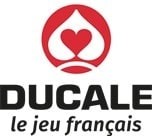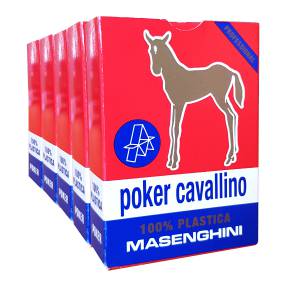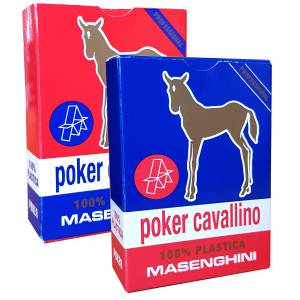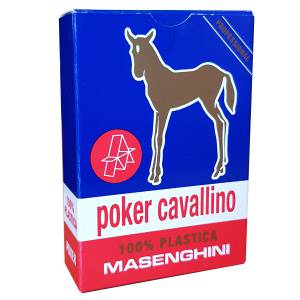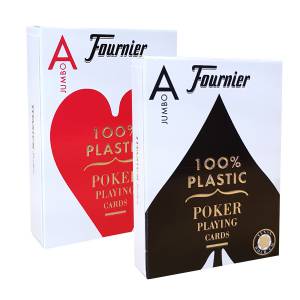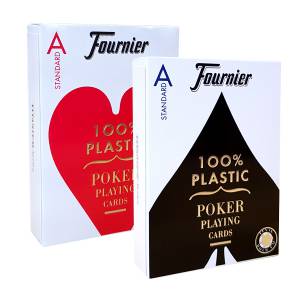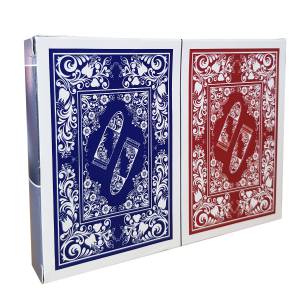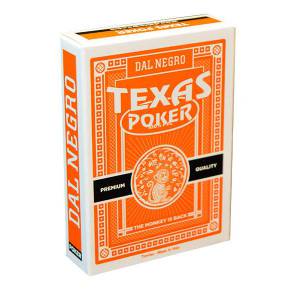Subcategories
-
Poker cards
WHICH POKER CARDS TO CHOOSE ?
Welcome to our dedicated poker cards category, the very essence of any quality poker game. On cartes-production.com, the leading French site for selling poker equipment and online casino games since 2008, we offer a wide range of poker cards to meet all your needs, whether you are an individual, a club, or a professional.
Our selection of poker cards includes 100% plastic cards as well as paper cards, all designed to provide an optimal gaming experience. Whether you prefer cards with jumbo indexes or standard size, we have what you need.
MENU
1 - Characteristics of poker card decks
2 - Cardboard or plastic poker cards?
3 - The choice of indexes: standard or jumbo
4 - The choice of indexes: 2 or 4
5 - The choice of indexes: 2 or 4 colors
6 - Packaging of poker card decks
7 - The back of poker cards: with or without a white border
Characteristics of Poker Card Decks:
- Types of Cards: 100% plastic (PVC) or cardboard
- Available Formats: Jumbo index or standard size
- American or French faces
- Packaging: Sold individually, in packs of 2, or in cartons of 12 or 14 decks
- Purchase Options: Poker cards suitable for individuals, clubs, and professionals
We provide you with maximum information about the characteristics of poker card decks in the product description section. Be sure to look at the icons to help you make your choice.

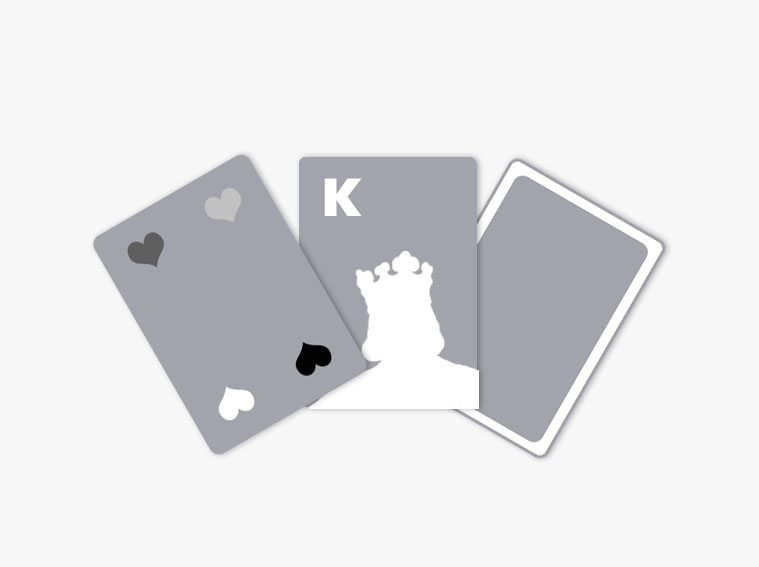
Our range of poker cards is designed for:
- Individuals looking to enhance their home poker nights
- Poker clubs wanting quality equipment for their members
- Professionals and tournament organizers aiming to provide a flawless gaming experience

We are proud to offer poker cards from renowned brands, ensuring quality and durability:
- MODIANO : CRISTALLO, TEXAS POKER HOLD’HEM
- FOURNIER : TITANIUM, EPT
- COPAG
- BICYCLE : RIDDER BACK, PRESTIGE
- And many others among a total of 15 prestigious brands.
Explore our wide range of poker cards and elevate your games with our high-quality equipment. Trust cartes-production.com, your preferred partner for all your poker and casino gaming equipment needs.

You have two choices for your poker games: classic laminated cardboard poker cards or 100% plastic (PVC) poker cards.
General Description of 100% Plastic (PVC) Poker Cards:
100% Plastic (PVC) poker cards are valued for their durability and ease of handling. Here are typical specifications for this type of cards, particularly suited for poker:
- Material: PVC (Polyvinyl Chloride) which offers high resistance to wear, water, and creases. This material allows the cards to return to their original shape even after being bent or twisted.
- Size: Poker size poker cards typically measure 2.5 inches wide by 3.5 inches long (approximately 63.5 mm x 88.9 mm). This size is slightly larger than bridge size, allowing for better handling especially in games where many cards are held in hand.
- Weight and Thickness: PVC poker cards are generally thicker and heavier than paper poker cards. They can vary in thickness, typically around 0.25 to 0.30 mm.
- Finish: PVC poker cards often feature a smooth or slightly textured finish to facilitate shuffling and dealing without cards sticking together.
- Durability: PVC poker cards are extremely durable and can last for years with regular use without significant signs of wear.
- Cleaning: Because PVC is waterproof, poker cards can be easily cleaned and disinfected, which is particularly useful in environments where poker cards are frequently used by many different people.
- Flexibility: These poker cards offer a good balance between rigidity and flexibility, allowing for good control during shuffling and handling.
- Visuals and Design: PVC poker cards can be printed with a variety of designs, from classic to modern, and may also include security features such as watermarks or UV elements to prevent counterfeiting.
- Cost: While more expensive than paper poker cards initially, their durability can make them more cost-effective in the long run.
- American Portrait: The face portraits on poker cards are traditionally American in poker games, featuring King, Queen, Jack indices, unlike French decks which have different face portraits and use Roi, Dame, Valet indices.
100% PVC poker cards are ideal for regular players or for use in environments where poker cards are subject to heavy wear, such as casinos or frequent gaming clubs.
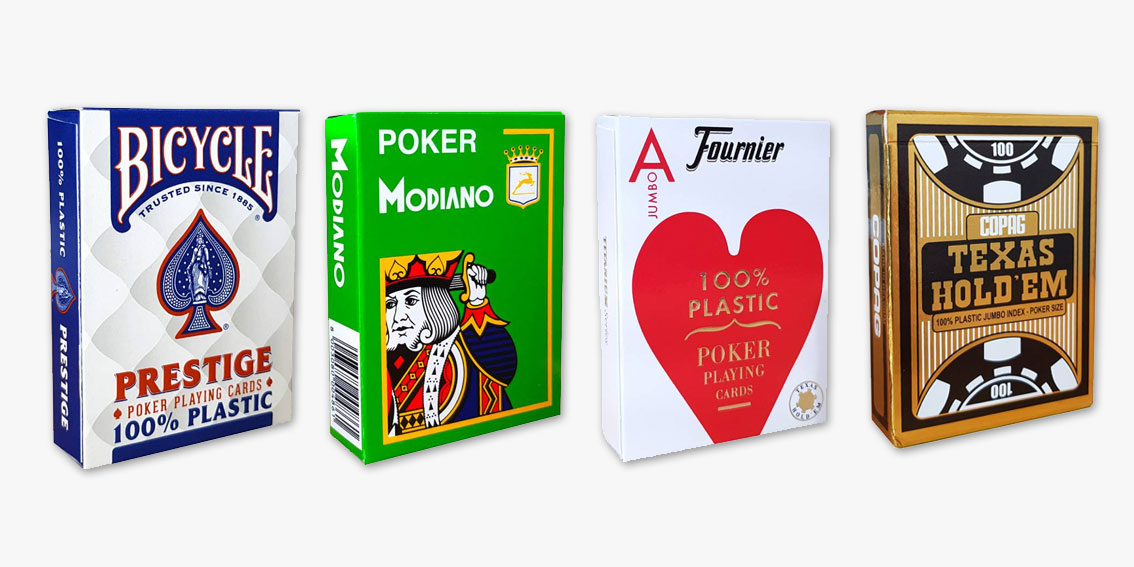
- Edit
- Duplicate Widget
- Remove Widget
General Description of Cardboard Poker Cards:
Cardboard poker cards, also known as paper cards, are a traditional and widely used choice for poker card games. Here are the typical specifications for cardboard poker cards in poker size:
- Material: Poker cards are typically made from high-quality cardboard or cardstock. This material can be single-layered or a blend of several layers of paper to enhance durability.
- Size: Similar to PVC poker cards, poker size cards generally measure 2.5 inches wide by 3.5 inches long (approximately 63.5 mm x 88.9 mm). This size is comfortable for handling and viewing. Some brands, like MASENGHINI, offer XL formats of 64 x 90 mm.
- Weight and Thickness: Cardboard poker cards are lighter than PVC poker cards. The thickness can vary, but they are generally thinner, which affects the feel in hand and ease of shuffling.
- Finish: Paper poker cards can have different finishes:
- Smooth finish: Basic, cheaper, but less durable and more prone to sticking or getting dirty.
- Plastic-coated finish: Provides some protection against water and wear, making the cards slightly more durable and easier to shuffle.
- Cushion finish for BICYCLE poker cards
- Cambric finish for BEE poker cards
- Linoid finish for TALLY HO poker cards
- Edit
- Duplicate Widget
- Remove Widget
- Durability: Cardboard poker cards are less durable than PVC ones. They can bend, get corners bent, or damage more easily, which may require more frequent replacement.
- Cleaning: They are more difficult to clean than PVC poker cards. Exposure to moisture can cause irreversible damage like warping or discoloration.
- Flexibility: Cardboard poker cards have good initial flexibility but may lose this quality over time and use, especially if exposed to moisture.
- Visuals and design: Like PVC poker cards, they can be printed with a wide variety of designs. However, details may fade faster due to wear.
- Cost: Cardboard poker cards are generally less expensive than PVC poker cards, making them attractive for budget-conscious consumers or situations where poker cards need frequent replacement.
- American portrait: The face portraits on cardboard poker cards are traditionally American in poker games, featuring the King, Queen, Jack index, unlike French games with different portraits and the Roi, Dame, Valet index.
Cardboard poker cards are ideal for occasional use or in environments where cost is a more significant factor than durability, such as home games or special events.

THE CHOICE OF INDEX: 2 or 4, standard or jumbo, 2 or 4 colors?
Standard (Regular) or Jumbo Index of Poker Cards
The differences between jumbo and standard indexes on poker cards primarily concern the size and visibility of the symbols (numbers and letters) in the corners of the cards. Here's how these two types of indexes compare:
Size of Symbols:
- Jumbo Index: Symbols on jumbo indexes are significantly larger than those on standard indexes. This larger size makes it easier to read the cards from a greater distance, which is particularly useful in games where players often need to view their cards from a distance, such as Texas Hold'em or other table games.
- Standard Index: Symbols are smaller and less intrusive, allowing for better discretion during gameplay. This can be advantageous in games where card privacy is more critical.
Visibility and Readability:
- Jumbo Index: Provides better visibility for individuals with vision impairments or in low-light conditions. Ideal for games involving many players or larger tables.
- Standard Index: While sufficiently visible for most situations, they may be harder to read for some players, especially at a distance or in low-light conditions.
Use in Games:
- Jumbo Index: Preferred in casinos and tournaments where clarity and ease of reading from a distance are crucial for smooth gameplay. They are also favored by older players or those with specific visual needs.
- Standard Index: Frequently used for home games or in contexts where players are closer together, such as bridge or closed poker.
Aesthetics:
- Jumbo Index: May be perceived as less elegant due to the larger size of numbers and letters, which can dominate the poker card's aesthetic.
- Standard Index: Often considered more traditional and subtle, retaining more of the original card illustration without being overwhelmed by numbers and letters.
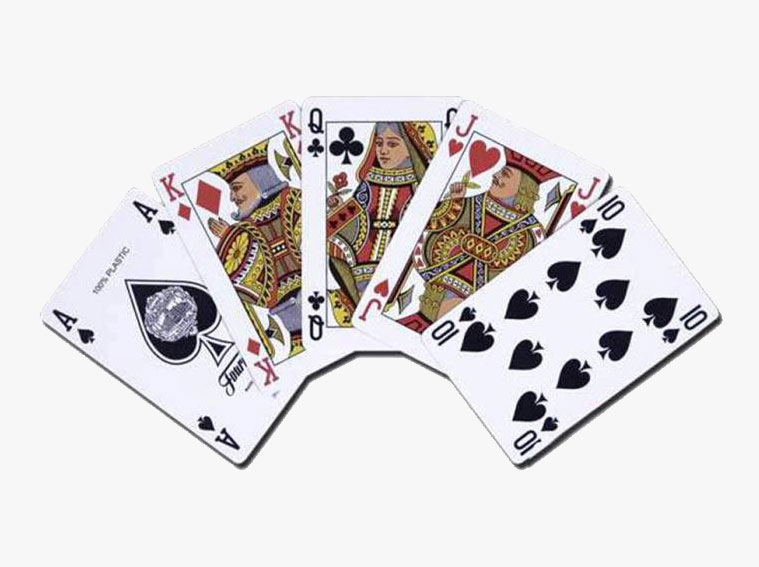

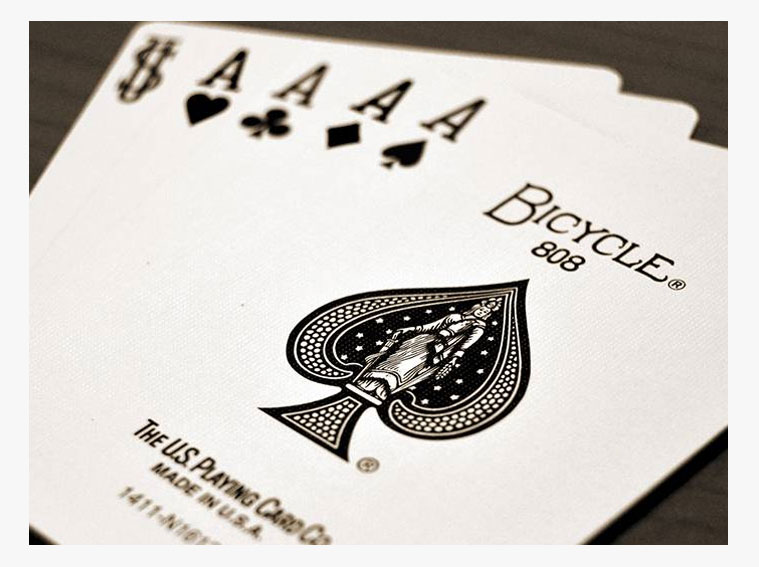
 https://youtu.be/o52DVEuUJoU?list=TLGGZh71YYEjxrUwMTA3MjAyNA
https://youtu.be/o52DVEuUJoU?list=TLGGZh71YYEjxrUwMTA3MjAyNAPlayer Preferences:
- Jumbo Index: Chosen by players who prioritize functionality and ease of reading.
- Standard Index: Preferred by those who appreciate a more classic and possibly more strategic gaming experience.
Each type of index has its own advantages and disadvantages, and the choice between jumbo and standard often depends on the specific circumstances of the game as well as the players' personal preferences.
Le choix entre des cartes de poker avec deux index (2-index) et quatre index (4-index)
The choice between poker cards with two indices (2-index) and four indices (4-index)

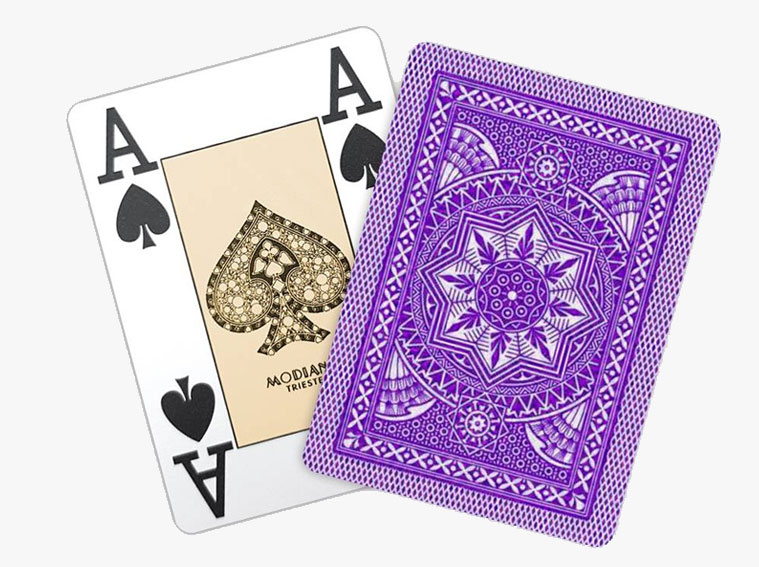
2-Index Poker Cards
- Layout: The two indices are located in the opposite corners at the top left and bottom right of each poker card.
- Traditional Use: This type of poker card is the most common and is used in most traditional card games. The layout is ideal for easily holding and organizing poker cards in one hand.
- Visibility: The indices are easy to read when fanned out in one hand, allowing for quick and discreet viewing of the poker card values.
- Aesthetics and Tradition: These poker cards maintain a more traditional appearance and are often preferred for games such as poker and bridge.
4-Index Poker Cards
- Layout: The four indices are located in each corner of the poker card, making the values visible from all angles.
- Flexibility in Use: 4-index poker cards are particularly useful for games where cards are often spread out on the table or held in a less traditional manner, such as in some casino or board games.
- Advantages for Group Games: In games with many players sitting around a table, 4-index cards allow all players to easily see the card values without having to manipulate or tilt them.
- Accessibility: They are also advantageous for individuals with movement or dexterity limitations who may find it difficult to hold cards in a traditional manner.
Choice of Indices Based on Game Context:
- Personal vs. Professional Games: For home games with friends or family, 2-index cards are generally sufficient. However, in environments like casinos or when it's important for all players to see the cards from any angle, 4-index poker cards are preferable.
- Comfort and Accessibility Considerations: If you are playing with elderly individuals, children, or people with specific visibility or card-handling needs, 4-index poker cards may offer a better experience.
- Type of Game: Consider how the poker cards will be used during the game. For more dynamic and interactive games where cards are often exposed to view, 4-index cards can provide added comfort.
In conclusion, the decision between two or four indices should be guided by how the cards will be used, who will be using them, and in what gaming environment they will primarily be employed.
WHAT CHOICE OF INDEX COLOR FOR POKER CARD GAMES ?
TRADITIONAL REDS AND BLACKS OR 4 COLORS ?The use of four colors for the indexes of poker cards, instead of the traditional two colors (red and black), offers several practical advantages, especially in complex games or situations where quick and precise identification of cards is crucial.
Here are some key reasons to choose a four-color deck:
Clarity and Distinction:
- Reduced Errors: In games where multiple suits are in play, such as bridge or certain types of poker, having four colors for the indexes can help avoid confusion between similar symbols, such as hearts and diamonds or clubs and spades.
- Rapid Identification: The different colors allow for quicker recognition of the various suits, which can speed up gameplay and reduce playing errors.
Enhanced Gaming Experience for Players with Specific Visual Needs:
- Players who have difficulty distinguishing colors (such as those with certain forms of color blindness) can benefit from a broader color palette, which helps differentiate suits more easily.
Utility in Multi-tasking Games:
- In complex games where players need to track multiple suits simultaneously, different colors can assist in managing and strategizing more effectively.
Use in Tournament and Competitive Environments:
- For competitive games, especially where decisions need to be made quickly under pressure, distinct colors for each suit can reduce the time needed to evaluate the hand and thereby improve player performance.
Aesthetic Preferences and Customization:
- Some players simply prefer the look of a four-color poker deck. This can also add an element of customization or novelty to a classic card game.
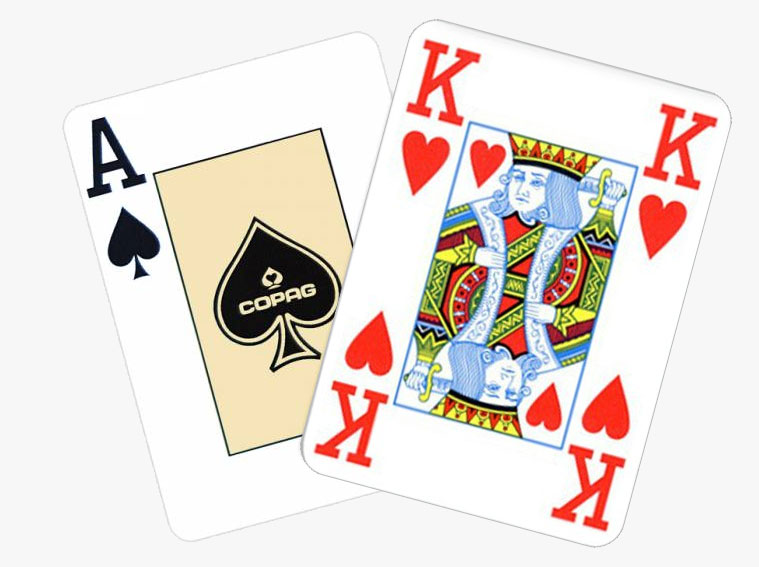

The packaging of poker card decks
Our poker card games are sold individually, in a duo pack (2 games of different colors), in packs of 10 games (Modiano, 10 different colors), in cases of 12 games (6 x 2 colors), or in packs of 14 identical games.
Why buy two poker card games of different colors:
Playing with two poker card games in the same session is a common practice, especially in group games and casino environments, for several strategic and practical reasons:
- Efficiency and Speed: Using two poker card games helps reduce waiting time between hands. While one deck is in play, the other deck can be shuffled and prepared by a dealer or another player. This allows for starting a new hand immediately after the previous one ends, optimizing gameplay time and keeping players engaged.
- Prevention of Cheating: Rotating between two poker card games reduces the risk of cheating. With only one deck, it could be easier for unscrupulous players to mark or remember the position of certain cards. Regularly changing the deck makes such attempts much more difficult.
- Card Wear: Alternating between two poker card games helps reduce natural wear and tear on the cards. In intensive gaming environments like casinos, where cards are constantly shuffled, dealt, and handled, cards can quickly become worn out. Using two decks alternately extends the lifespan of each deck.
- Enhancement of Game Flow: In tournaments or serious poker games, maintaining smooth gameplay is crucial. Using two poker card games helps maintain this flow, reducing interruptions and downtime that can disrupt player concentration and engagement.
- Adaptation to Large Tables: In games with a large number of players, such as certain tournament formats, having multiple poker card games can facilitate card management and ensure faster and more efficient distribution.
- Consistent Game Quality: By alternating between poker card games, you ensure that the cards remain in good condition, providing a fair and high-quality gaming experience. Well-maintained poker cards are essential for precise shuffling and handling.


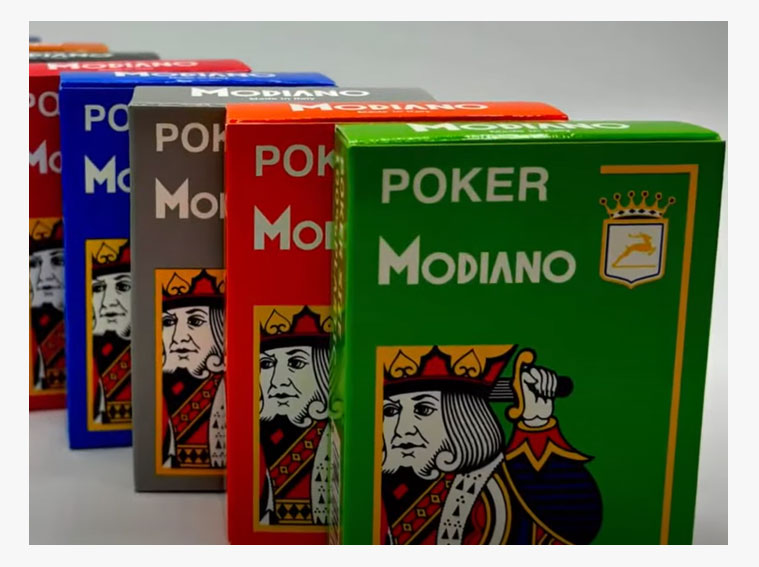
In essence, using two decks of poker cards during a poker game aims primarily to enhance the overall gaming experience by increasing efficiency, reducing cheating risks, minimizing card wear, and ensuring consistent game quality.
This is particularly useful in professional and competitive environments where every detail matters.
The back of poker cards: with or without a border?
Choosing poker cards with a back featuring a solid white border around the edges can offer several practical and aesthetic advantages for the game:
Protection against Wear and Cheating:
- Concealing Wear: The edges of poker cards typically wear out faster than the rest of the card, especially in games where cards are frequently shuffled and handled. A white border can help conceal minor wear and imperfections that develop over time, keeping the cards visually uniform for longer.
- Preventing Cheating: White borders make it more difficult to mark poker cards for cheating purposes. In fully colored or intricately patterned cards that extend to the edge, it may be easier to discreetly mark or identify cards based on small alterations or edge wear.
Enhanced Visibility:
- White borders around poker cards can help distinguish different cards more easily when stacked or overlapped. This can be particularly useful in fast-paced games where quickly recognizing the cards in play is crucial.
Aesthetic and Design:
- A white border can provide aesthetic contrast that enhances the patterns and colors of the poker card backs. This can improve the overall appearance of the poker card set, adding an element of style and sophistication.
- In addition, a design with a white border can give a sense of cleanliness and order, making the game visually appealing and easier to follow for players.
Visual Consistency:
- In some cases, the white border can help maintain visual consistency during the game, ensuring all poker cards appear identical when viewed from the side, reducing the chances of cards being identified by cut or color variations.
Focus on Information:
- The contrast created by the white border can also help direct players' focus to the center of the card, where important information like the number and symbol is presented. This can facilitate quick card reading, which is advantageous in games where speed is essential.
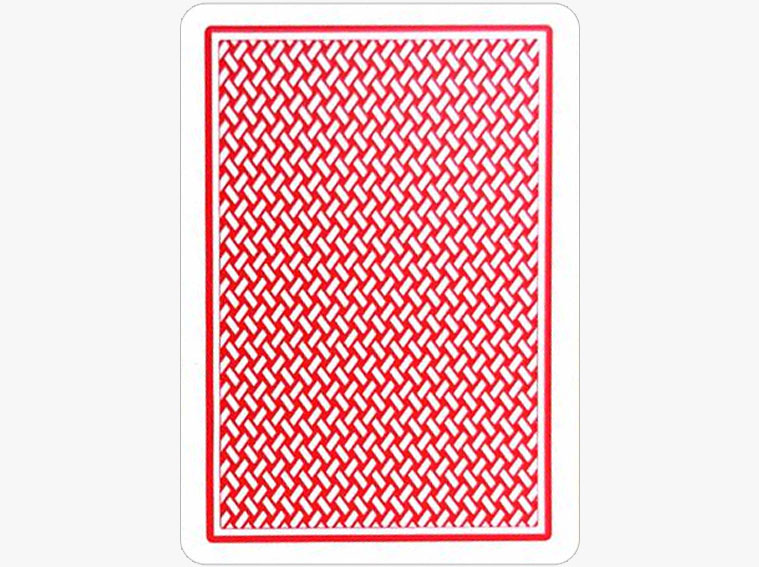

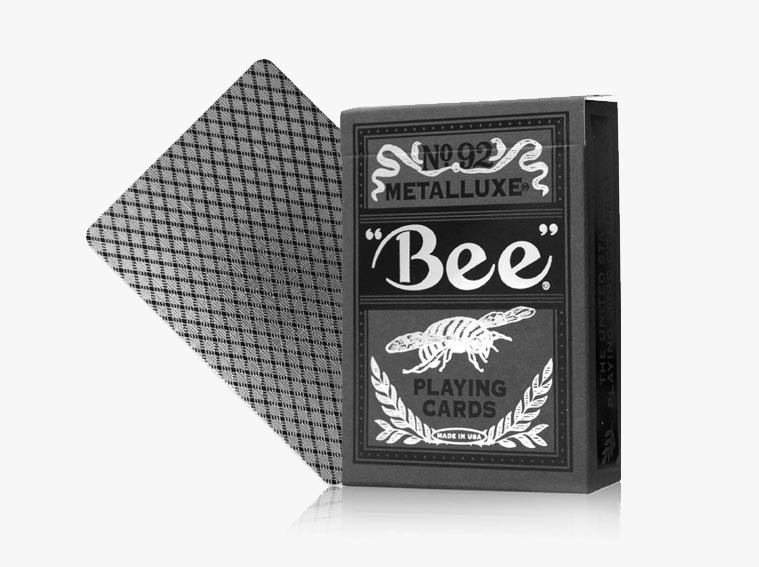

Overall, the presence of a white border around poker cards combines functional and aesthetic advantages, contributing to durability, game security, and enhancing players' visual experience.
-
Poker table tops
-
Cases
-
Poker chips
WHICH POKER CHIPS TO CHOOSE?
For any poker enthusiast, there is nothing more satisfying than the sensation of handling poker chips, meticulously lining them up in front of oneself, and skillfully tossing them onto the table. This unique, almost tactile pleasure reaches its peak when preparing for one's own game, opening a case, and arranging the poker chips for each player.
This in-depth guide explores the different types of poker chips available, helping you choose the one that best suits your needs.
MENU
1 - Plastic poker chips without metal insert
2 - Plastic poker chips with metal insert
3 - ABS plastic poker chips with stickers
4 - Composite clay poker chips
5 - Ceramic Poker Chips
6 - Clay Poker Chips
1 - Jplastic poker sticks without metal insert
Plastic ABS poker chips without a metal insert represent an economical and practical option for beginner players or those who organize occasional poker games. Here is a detailed description of these poker chips:
Manufacturing of Plastic Poker Chips
These plastic poker chips are made from ABS plastic (Acrylonitrile Butadiene Styrene), a thermoplastic polymer known for its impact resistance and durability. Unlike other poker chip models, these do not contain a metal insert, making them lighter and less expensive to produce. The manufacturing process typically involves injection molding, where the plastic is melted and injected into molds to form the poker chips. This process allows for rapid and efficient mass production, ideal for meeting the demand for economical poker chips.
Use of Plastic Poker Chips
The plastic ABS poker chips without a metal insert are perfect for players not necessarily seeking a premium gaming experience but rather a functional and affordable solution. They are ideal for games among friends, student associations, or as beginner poker chips for those learning the rules and strategies of poker without a significant initial investment. Their lightness and simplicity also make them easy to transport and store.
Characteristics of Plastic Poker Chips
- Weight: Each chip weighs approximately 2 to 4 grams, which is significantly lighter than poker chips with a metal insert. This lighter weight can influence how the poker chips fall or are handled during the game.
- Diameter: The standard diameter of these poker chips is 39mm, which corresponds to the usual dimensions in recreational poker games.
- Texture and Finish: The surface of ABS plastic poker chips is generally smooth, with sometimes embossed patterns to improve grip. The variety of colors is vast, allowing for simple yet effective visual customization for different denominations or types of games.
- Chips with or without Values: These poker chips are usually solid-colored or two-toned, with or without any values. This allows each player to manage their own game structure.
- Price: These poker chips are very affordable, often sold in large quantities for a minimal cost, making poker more accessible to a wider audience.


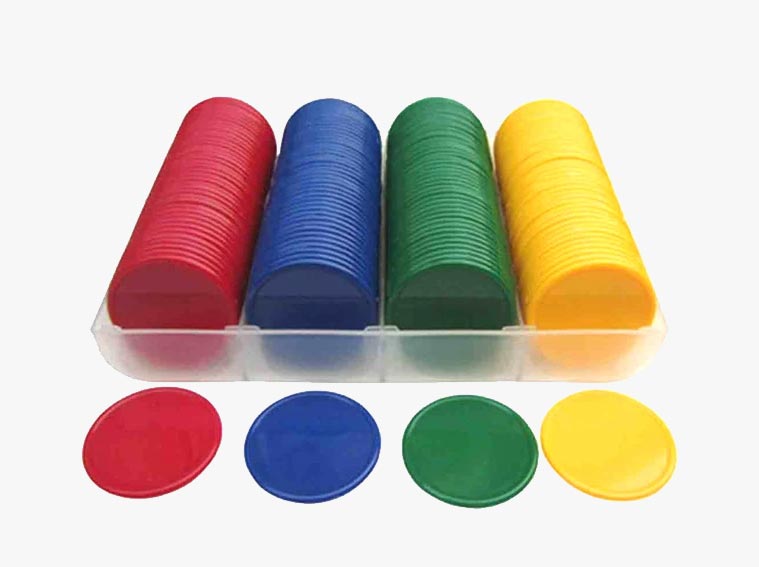
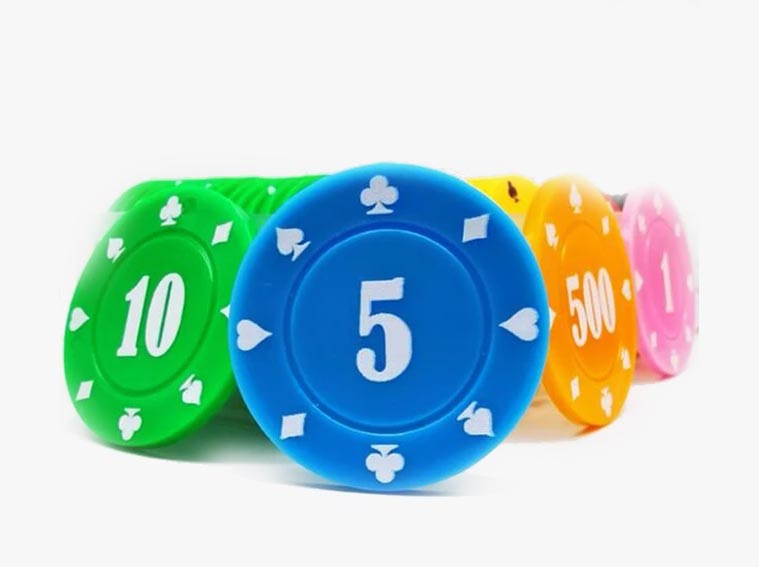
The plastic ABS poker chips without a metal insert offer a basic and economical solution for casual players or beginners. While they do not provide the characteristic weight or sound of higher-end casino poker chips, they effectively fulfill their role for a simple and unpretentious poker game.
2 - Plastic poker chips with metal insert
The plastic ABS poker chips with a metal insert combine the lightness of plastic with the additional weight of metal, offering a more pleasant feel and better handling during the game. Here is a detailed exploration of these poker chips:
Manufacturing Plastic Poker Chips with Metal Insert
These poker chips are made from Acrylonitrile Butadiene Styrene (ABS), a plastic renowned for its robustness and resilience. The addition of a metal insert in the center of the poker chip sets them apart from other plastic poker chips. This metal core is wrapped in colored ABS plastic, which is then molded to form the final chip.
This manufacturing method results in a heavier chip, improving the tactile and sound experience compared to chips made entirely of plastic.
Using Plastic ABS Poker Chips with Metal Insert
The plastic ABS poker chips with metal insert are particularly suitable for beginner players who seek a gaming experience closer to that of casinos, without investing in high-end poker chips. They are excellent for home poker games, associations, charity events, or as a first acquisition for new players.
Their durability and affordable cost also make them perfect for environments where gaming is frequent but budget is limited.
Characteristics of Plastic Poker Chips with Metal Insert
- Weight: Each chip weighs approximately 12 grams, significantly heavier than poker chips without a metal insert. This additional weight offers a better feel in hand and mimics the touch of more expensive poker chips.
- Diameter: The standard diameter of 40 mm ensures uniformity with the majority of poker chips used in recreational and professional games, facilitating handling and shuffling.
- Texture and Finish: The surface of the poker chips can feature different designs, such as DICE or SUITED, which are classic patterns in the poker industry. These patterns are not only decorative but also offer a slightly raised texture that improves the grip of the poker chips.
- Chips without Values: These poker chips are usually solid-colored or two-toned (color and white), without any values. This allows each player to manage their own game structure.
- Price: Despite their superior quality compared to poker chips without a metal insert, these chips remain in an affordable price range, making them accessible to a wide audience.
Brands and Models of Plastic ABS Poker Chips with Metal Insert
- DICE: Often decorated with dice motifs on the edges, this type of poker chip is a classic and very popular for home games.
- SUITED: This model features card suit symbols (hearts, diamonds, clubs, spades) on its edge, giving it a more poker-related look.
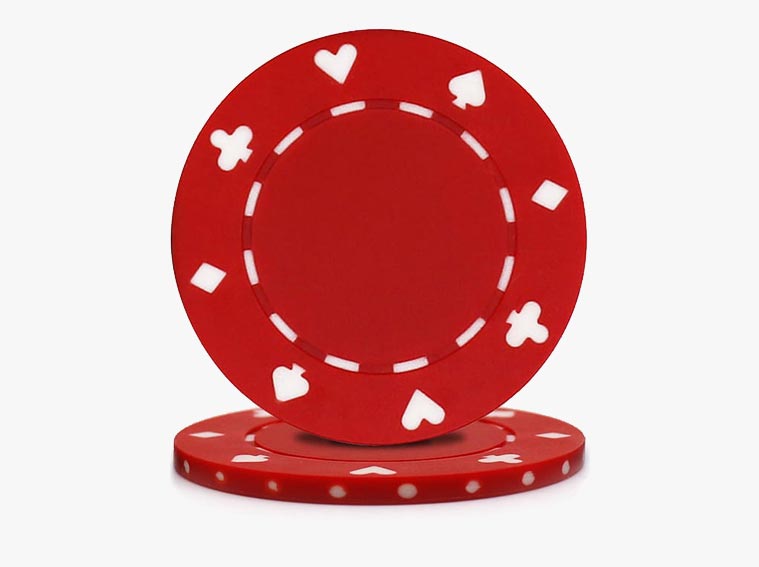 https://youtu.be/CteE8oLKTs8?list=TLGGfZevMYlx404wMTA3MjAyNA
https://youtu.be/CteE8oLKTs8?list=TLGGfZevMYlx404wMTA3MjAyNA


The plastic ABS poker chips with a metal insert offer an excellent entry-level option for those looking to enhance their gaming experience without spending a fortune. They combine durability, pleasing aesthetics, and a satisfying weight, making them ideal for various recreational gaming situations.
3 - ABS plastic poker chips with stickers
The plastic ABS poker chips with metal insert and central sticker are an excellent option for those seeking a compromise between cost and quality. These poker chips combine durability with an attractive design, making them ideal for beginner players or casual games.
Manufacturing of Plastic ABS Poker Chips with Stickers
These poker chips are made from ABS plastic (Acrylonitrile Butadiene Styrene), a thermoplastic polymer known for its impact resistance and rigidity. The metal insert in the center of the chip adds significant weight, giving the poker chips a heavier and more pleasant feel when handled. This additional weight also helps stabilize the poker chips during shuffling or tossing on the gaming table.
On the top of each chip, a decorative sticker is applied. This sticker is typically printed with colorful patterns and numerical values, which not only enhances the chip's appearance but also aids in identifying different denominations during gameplay. The designs of the stickers can vary, offering a range of styles that may include both classic and modern elements.
Using Plastic ABS Poker Chips with Stickers
These poker chips are particularly suited for beginner players or those who host occasional home poker games. Their affordable cost makes them accessible to a wide audience, and their attractive design enhances the gaming experience without requiring a substantial investment. They are also popular for events such as themed parties or amateur tournaments.
Characteristics of Plastic ABS Poker Chips with Stickers
- Weight: Each poker chip weighs approximately 11.5 to 13.5 grams, offering a satisfying heaviness that is often sought after by those who appreciate a more authentic gaming experience.
- Diameter: The diameter of these poker chips is slightly larger than standard, measuring 40 mm, which makes them easy to handle, especially for less experienced hands.
- Price: These poker chips are priced in the mid-range, making them affordable while offering superior quality compared to lower-end poker chips.
- Colors and Designs: Available in numerous colors, these poker chips can feature various designs such as, WELCOME LAS VEGAS, ROYAL FLUSH, RUNNER UP, ULTIMATE POKER CHIPS, and CELTIK. These patterns add an attractive visual aspect and can help reinforce the theme of a gaming night.
- Cash Game or Tournament: These poker chips come in various denominations, allowing players to use them for cash games with smaller amounts (0.25, 0.5, 1...) or high-value tournaments (20,000, 50,000, 100,000).


The plastic ABS poker chips with metal insert and sticker are an excellent option for beginners in the world of poker or for those looking to organize games without a large investment. Their combination of durability, attractive design, and reasonable cost makes them a popular choice for recreational games. With their variety of colors and patterns, these poker chips can also add a personalized and fun element to any poker night.
4 - Clay Composite Poker Chips
Clay composite poker chips combine the benefits of multiple materials to create a gaming option that is both durable and aesthetically pleasing. This type of chip is a popular choice among players seeking casino-quality without the high cost associated with pure clay chips. Here's an in-depth exploration of their features, manufacturing, and usage:
Manufacturing Clay Composite Poker Chips
Clay composite poker chips are made from a composite resin, a sturdy blend of plastic and clay particles. This combination creates a chip that mimics the feel and sound of traditional clay poker chips used in casinos, while being more resistant to impacts and general wear. The manufacturing process often involves adding a metal insert to increase the weight of the chip, enhancing the feel in hand and providing a superior quality impression during handling.
Using Clay Composite Poker Chips
Clay composite poker chips are ideal for players seeking a professional gaming experience at home or in advanced amateur tournaments. They are also well-suited for poker clubs and charity events where an authentic gaming feel is desired without the prohibitive cost of pure clay poker chips. These poker chips are perfect for those who value quality and durability while considering their budget.
Features of Clay Composite Poker Chips
- Weight: These poker chips weigh 13.5 grams, an ideal weight that balances ease of handling with a substantial feel in hand.
- Diameter: The standard 40 mm diameter ensures uniformity with poker chips used in professional casinos, making them suitable for various gaming environments.
- Texture and Finish: The surface of clay composite poker chips can feature a range of textures, from smooth finishes to embossed patterns, enhancing grip and aesthetic appeal. Finishes may include classic designs like dice, suited patterns, or more customized designs.
- Price: A set of 300 clay composite poker chips can be purchased for approximately €80, offering excellent value for serious players who want a superior gaming experience without breaking the bank.
- Available in a Variety of Colors and Denominations: These poker chips come in different designs, such as CROWN, DIAMOND, CHIPS PALACE, HERITAGE, or SUNSHINE. These designs add visual appeal and can complement the theme of a gaming night.
- Cash Games or Tournaments: These poker chips are available in various denominations, allowing players to participate in cash games with small stakes (0.25, 0.5, 1, etc.) or large-scale tournaments with high values (20,000, 50,000, 100,000).


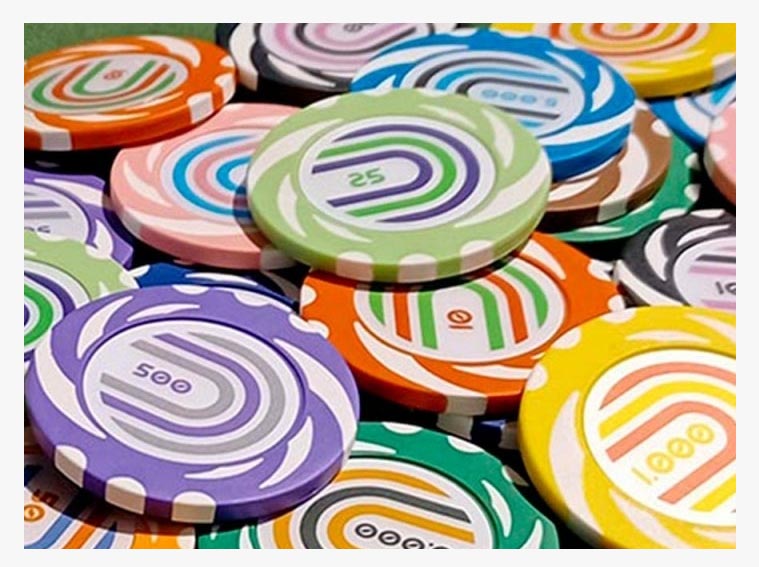
Clay composite poker chips offer a fantastic alternative to pure clay poker chips for players seeking a high-quality gaming experience at an affordable price. Their durability, combined with a pleasant weight and aesthetic, makes them perfect for a variety of gaming contexts, from home games to local tournaments. They are a wise choice for those who value both quality and cost-effectiveness in their gaming equipment.
5 - Ceramic Poker Chips
Ceramic poker chips are renowned for their high quality and flexibility in terms of customization. Used by professional players and discerning amateurs alike, these poker chips are a popular choice for large-scale tournaments and high-level home poker games.
Manufacturing Ceramic Poker Chips
Ceramic poker chips are made from a composite ceramic base, which makes them incredibly durable while offering a smooth and pleasant touch surface. One of the major advantages of ceramic is its ability to be fully printed across the entire surface, allowing for complete customization with high-resolution color graphics. This printing technology ensures that patterns and text are not only clearly visible but also highly durable, resistant to fading over time and frequent use.
Using Ceramic Poker Chips
Ceramic poker chips are a standard in international tournaments such as the World Series of Poker (WSOP), valued for their professional quality and handling. They are particularly appreciated for their stability and ease of stacking, essential features during fast-paced games and with large stacks. Their slightly rough texture ensures excellent grip, allowing players to handle ceramic poker chips with precision and confidence.
Characteristics of Ceramic Poker Chips
- Weight: Each chip has a standard weight of 10 grams, ideal for a solid feel without being too heavy, facilitating manipulation and gameplay.
- Diameter: The 39mm diameter meets the specifications of poker chips used in casinos and professional tournaments, ensuring a consistent gaming experience.
- Finish: Ceramic poker chips have a smooth or textured finish.
- Customization: Fully customizable, ceramic poker chips allow players to choose from a wide range of designs or create their own graphics, making them particularly appealing for customized events or private collections.
- Price: The cost of 300 ceramic poker chips ranges from €200 to €400, reflecting their superior quality and customization options.
- Cash Game and Tournament: Available in various denominations, these chips enable players to participate in cash games with small stakes (0.25, 0.5, 1, etc.) or high-stakes tournaments (20,000, 50,000, 100,000).
- Colors and Designs: Available in a variety of colors and values, ceramic poker chips feature different designs such as FRENCH POKER TOUR, THE SHARK, or HONG KONG STAR. These designs enhance visual appeal and can complement the theme of a gaming event.



Ceramic poker chips offer a perfect blend of quality, durability, and customization, making them ideal for serious players and high-level tournaments. Their ability to be fully customized with fine details also makes them highly sought after for special events or as collectible items. By choosing ceramic poker chips, players ensure a top-quality gaming experience with chips that not only perform well but also have an impressive visual appeal.
6 - Paulson Type Clay Poker Chips
Paulson clay poker chips are considered the elite in the world of poker accessories, offering an unparalleled gaming experience. Manufactured with high-quality materials and meticulous attention to detail, these poker chips are the benchmark for professional casinos and serious players worldwide.
Manufacturing of Paulson Clay Poker Chips
Paulson poker chips are exclusively made from clay, without the plastic additives commonly used in other types of poker chips.
This manufacturing process involves specialized techniques where clay is compressed under high pressure to form the poker chips, ensuring high durability and an authentic touch. Each chip is then hand-painted, and the designs are embedded into the chip rather than merely printed on the surface.
This embedding technique ensures that the design does not fade over time and gives the poker chips a unique texture that enhances handling.
Using Paulson Clay Poker Chips
Paulson clay poker chips are used in the most prestigious casinos worldwide, such as the Bellagio and Caesars Palace. Their superior quality makes them a preferred choice for high-stakes poker tournaments, private gaming rooms, and collectors. These poker chips are particularly favored by players looking to recreate the ambiance and experience of high-stakes poker tables at home.
Characteristics of Clay Poker Chips
- Weight: Paulson poker chips typically have a standard weight of 10 grams, which corresponds to the regulatory weight of casino poker chips.
- Diameter: These poker chips have a diameter of 39 mm, allowing for easy handling and a gaming experience that meets casino standards.
- Texture and Finish: Paulson poker chips have a remarkably smooth texture with a matte finish that reduces glare and facilitates chip handling during games. The edges are often precision-cut, offering a pleasant feel and easy stacking during gameplay.
- Designs: Paulson poker chips feature a variety of designs, ranging from classic styles to more modern motifs, all characterized by rich colors and exceptional clarity. The designs are integrated into the clay, allowing for a variety of textures and reliefs that are not possible with printed poker chips.
Price of Clay Poker Chips
Paulson clay poker chips are among the most expensive on the market due to their superior quality and artisanal manufacturing process. Prices can vary significantly depending on the rarity of designs and specific collections.


Paulson clay poker chips offer a luxurious gaming experience and are a true investment for poker enthusiasts. Their quality, durability, and aesthetic beauty set them apart from other types of poker chips, making them a preferred choice for those seeking the best in the world of poker.
For players who value authenticity and prestige, there is no better choice than Paulson poker chips.
Conclusion
These insights should help you make an informed decision based on your specific needs. Whether you're looking for poker chips for casual home games or serious competitions, it's essential to choose poker chips that not only meet your expectations in terms of quality and budget but also enhance your gaming experience.
For a safe and personalized purchase, consider cartes-production.com, where you can also test different types of poker chips by ordering them individually before making your final choice.
-
Poker mats
-
Poker accessories
-
Poker table accessories
-
Game tables
-
Poker DVD books
-
Custom poker
-
Empty cases & storage
-
Poker sets
-
Poker licenses
-
Poker chip cases
-
Our brands
-
Custom ceramic poker...
-
Custom PolyInno poker...
-
Ceramic chip keychains
-
Clay stickers poker chips
-
ABS stickered poker chips
-
Custom dealer buttons...
-
Custom poker plaques
